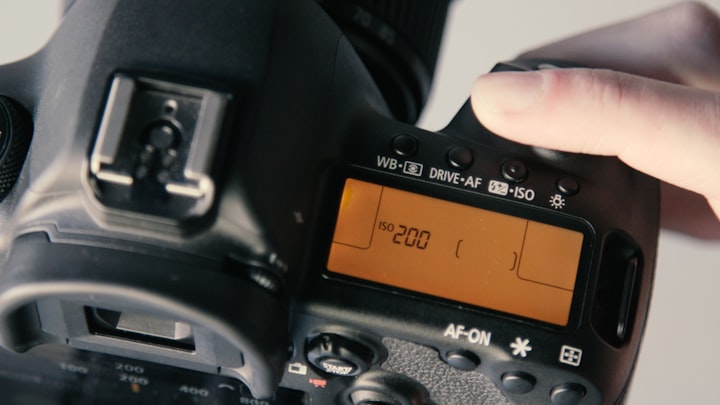What ISO in photography?
A beginner's guide to photography
What is ISO?
In photography, the ISO specifies the sensitivity of an imaging device to light. It is commonly used as a measure of how quickly an image sensor can capture ambient photons by measuring their quantity and quality. The higher the ISO setting refers to the more sensitive the sensor will be to outside light.
When using the ISO in the absence of a light meter, the shutter speed specifies the length of time the shutter in the camera stays open. In turn, the shutter speed is the amount of time required for the camera to allow light into the camera and expose the photo.
What are the common ISO range Values?
The ISO range for film photography is 100 to 1600. The ISO range for digital photography is 100 to 12800 in some models. Values are also expressed in numbers, so the higher the number, the more sensitive the film or sensor is to light.
Film and sensors need minimum illumination to work. The ISO is not related to the sensitivity of the film or sensor directly, but it has an effect on the minimal illumination needed to get a correct exposure.
What is Native ISO?
The native ISO of a camera is the sensitivity that the camera was set at when it is manufactured. In the photography realm, the native ISO of a camera is the lowest possible sensitivity setting for that camera. In most cases, this is set to 100 ISO in order to provide the best quality images in terms of noise and grain.
The native ISO can also be difficult to determine. If a camera is set at ISO 100, the surface of the sensor will have a lower light sensitivity, which may make it difficult for the camera to capture images in low-light environments.
However, if a camera is set at ISO 3200, the surface of the sensor will have higher light sensitivity, making pictures from that camera easier to capture in low-light environments.
What happens at a low ISO setting in DSLR?
One of the most important aspects of low-light photography is using a low ISO setting in a DSLR camera. The use of a lower ISO will ensure that less noise is created, while still maintaining a high shutter speed and aperture.
In order to get a clean indoor shot without an excessive amount of light pollution, use a low ISO setting, which will come out with more natural colors and details. You can also use the flash, but you will need to adjust the ISO setting to a higher setting to have the flash work well.
What happens at a high ISO setting in DSLR?
A high ISO setting in DSLR is where the camera sensor detects and amplifies any available light. This allows for quicker shutter speed and higher quality images in low-light circumstances. High ISO settings can be detrimental to an image when there is a lot of noise or graininess, causing photographs to appear gritty and not clear.
As a result, the aperture controls the amount of light that enters the lens through its opening and onto the sensor, thereby affecting the image brightness. The higher ISO settings also enable fast shutter speeds in low light conditions. These two factors allow photographers to achieve images with good quality images even in dimly lit environments.
What is ISO default setting should You use?
The ISO default setting should be a lower value because it will make the photo appear darker, which can lead to a higher chance of having a clear picture. The preferred ISO setting should be at 100, but you should experiment with different settings depending on the situation, your preference, and what your camera is capable of doing.
In this setting, the photos will have no grain in them and will be clear with minimal image noise. The downside to this setting is that it will take significantly longer for the camera to process the photo, meaning that if there are any moving subjects, you'll need to adjust your settings accordingly.

Boost image quality with low ISO setting?
The use of the low ISO setting on a digital camera will help to increase the quality of an image by lessening the amount of noise in the final picture. If you set your camera to low ISO, it will be easier for the sensor to find and identify the contrast and detail of an image which can result in a sharper and more detailed photo.
The major disadvantages to using a low ISO setting are that it is more difficult for a camera to take a photo and that the shutter speed is reduced, resulting in images with less light and more blur.
Misconception about ISO.
A variety of misconceptions about ISO has led to various myths.
The misconception about ISO is that it controls the exposure, while the truth is that it only impacts the camera's sensitivity to light.
More importantly, many people have assumed that higher ISO levels will always produce a better picture when in reality there are also good values for lower values.
There are some who believe that they can set their cameras to high ISO for nighttime pictures without having to use a tripod, which is incorrect.
Another misconception people have is that a higher ISO means less noise, but this is only true if you're using a more advanced camera with a better sensor. Shutter speed can be used strategically to compensate for low light situations or create more motion blur.
ISO standards can help you determine the correct ISO for a situation, however, ISO is not 100% perfect. ISO settings have their limitations. It's hard to tell the difference between the 100, 200, and 400 ISO settings on some cameras.
Conclusion
In conclusion, ISO is a way of measuring how sensitive your camera's sensor is to light. A higher ISO setting will give brighter images, but the increased sensitivity also introduces more noise. A lower ISO setting will produce darker photographs, but with less noise.
Choosing which ISO is most appropriate for your photo will help you take better pictures. Knowing camera ISO is a good thing to understand if you want to take advantage of the digital age of photography. This article has been a great start for those who are new to understanding camera ISO, and as always, there’s plenty more to explore what camera ISO does and how it affects your photos, as well as the pros and cons of different settings.
About the Creator
Lanz Jalal
I am a professional photographer, a foodie, a blogger, and a Singapore local Google guide. I love capturing the little details in life that make it worth living.







Comments
There are no comments for this story
Be the first to respond and start the conversation.